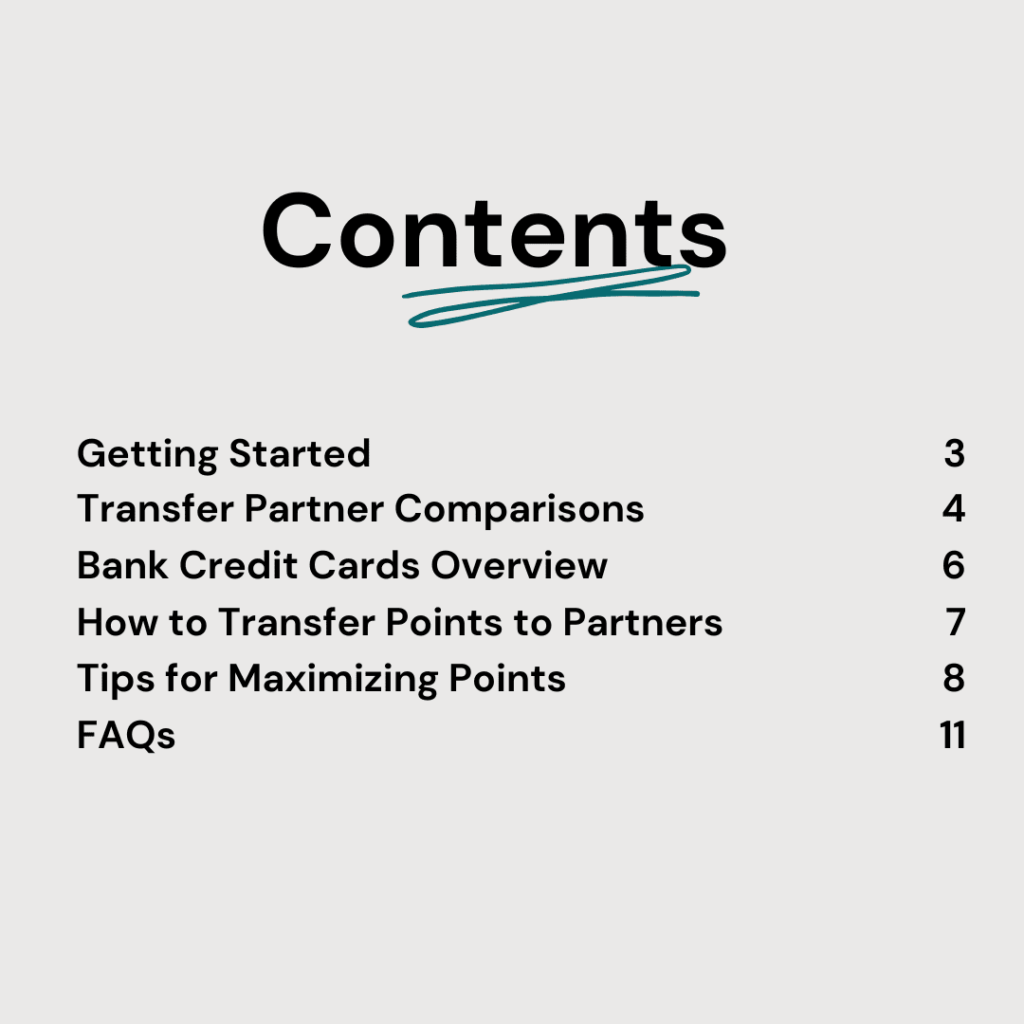
A travel credit card can turn your everyday spending into travel opportunities, but it can be tricky to pick the right one to begin with.
Disclosure: This post may contain affiliate links, which means we’ll receive a commission if you purchase through our links, at no extra cost to you. Please read full disclosure for more information.
If you’re new to travel credit cards, finding the right one can feel overwhelming. With so many options and perks, where do you even start?
As budget travelers who’ve explored over 50 countries (often thanks to credit card points), we’re here to help you figure out which card might work best for you.
But let’s be clear: this is just our opinion based on our personal experience, not financial advice. Always do your research and decide what’s right for your situation.
Starting with the right card is crucial because many credit cards only allow you to earn a sign-up bonus (which is one of the biggest ways to earn points) once.
For example, if you start with the Amex Platinum, you might not be eligible for the Amex Gold sign-up bonus later.
Beyond that, you’ll want a card that aligns with your travel goals and lifestyle, ensuring you get the most value out of it.
If you’re new to travel credit cards, we recommend starting with one that matches your goals and has a low (or no!) annual fee.
Before diving in, remember: If you can’t use credit responsibly, it’s better not to start at all. The last thing you want is to go into debt trying to save on travel.
Keep reading to start identifying the best starter travel credit card for you!
Step 1: Identify Your Travel Goals
Ask yourself:
- Do you have a specific destination or experience in mind?
- Are you looking for premium travel perks, or do you simply want to travel more?
- Is your focus domestic or international travel?
For example, we had a dream of staying in an overwater bungalow in Bora Bora. To make it happen, we researched airlines flying there (United via Tahiti) and hotels in Bora Bora (Conrad Hilton).
Knowing this helped us choose the Chase Sapphire Preferred for flights (thanks to its flexible points and United transfer partner) and a Hilton credit card for hotel stays.
Between these two cards, we spent four nights in a private overwater bungalow using points.

If you don’t have a specific goal, cards with transferable points like the Chase Sapphire Preferred are great because they give you flexibility to transfer points to multiple travel partners.
Want to learn more about credit card transfer partners? This guide will simplify it all and help you travel smarter.
Step 2: Check Your Credit Score
Most travel credit cards require a good to excellent credit score. Here’s what to know:
- Use free tools like Credit Karma to check your score.
- Many credit cards offer pre-approval tools that give you an idea of your approval odds without a hard credit check.
- Be aware that applying for a card typically involves a hard credit inquiry, which could temporarily lower your score.
If your credit needs improvement, focus on building it before applying for travel cards.

Step 3: Match Your Travel Frequency and Spending Habits
When choosing your first travel credit card, it’s crucial to think about how often you travel and how you spend:
- Do the perks align with your lifestyle?
For example, a card that offers lounge access or travel credits might sound appealing, but if you don’t travel frequently enough to use these perks, the annual fee may not be worth it. - Calculate the card’s value to you.
Look at the perks and benefits: How much are they worth compared to the annual fee? For instance, if a card offers an Equinox membership or luxury perks you won’t use, you’re essentially paying for benefits you won’t enjoy. - Focus on your spending habits.
Where do you spend the most? If dining out, grocery shopping, or booking travel are regular expenses, look for cards that reward those categories with bonus points.
If you’re just starting out, consider avoiding high annual fees unless you’re sure the perks will pay off.
Beginner-friendly options like the Chase Sapphire Preferred or Capital One VentureOne are great choices—they offer valuable rewards with reasonable fees and straightforward benefits.
While perks like lounge access or travel insurance may seem tempting, they’re only worth it if they truly fit your travel style.
Start with a card that matches your habits and goals, and you’ll set yourself up for travel rewards success without overcommitting.

Step 4: Evaluate Sign-Up Bonus Requirements
Sign-up bonuses are one of the best reasons to get a travel credit card, but they often come with spending requirements.
Here’s how to evaluate them:
- Compare bonuses across cards. For example, a Hilton card might offer 180,000 points, while the Amex Platinum offers 150,000 points. At first glance, the Hilton card may seem better, but you’ll need to know that Amex points transfer to Hilton at a 1:2 ratio. That 150,000 Amex bonus is actually 300,000 Hilton points—double the value.
- Assess whether you can meet the spending requirement without overspending. Plan your regular expenses to hit the minimum spend responsibly.

RELATED ARTICLE: How to Use Credit Card Points for Travel
Recommended Starter Cards
Here are some of the best beginner-friendly travel credit cards:
Low or No Annual Fee Options
- Capital One Venture
- Annual Fee: $95 USD
- Rewards: 2x miles on everything; 5x miles on hotels and rental cars through Capital One’s portal
- Perks: Global Entry/TSA PreCheck credit; no foreign transaction fees
- Citi Strata Premier® Card
- Annual Fee: $95 USD
- Rewards: 3x points on groceries, gas, flights, and dining
- Perks: Comprehensive travel protection; no foreign transaction fees
- Chase Sapphire Preferred
- Annual Fee: $95 USD
- Rewards: 3x points on dining; 1:1 point transfer to partner airlines and hotels
- Perks: DoorDash DashPass; $50 USD Chase Travel Credit; no foreign transaction fees
- Bilt Mastercard
- Annual Fee: $0 USD
- Rewards: Points for paying rent (without fees); 2x points on travel
- Perks: No foreign transaction fees
- Hilton Honors Card
- Annual Fee: $0 USD
- Rewards: 5x points on dining, groceries, and gas; 7x points at Hilton properties
- Perks: Fifth night free on award stays; no foreign transaction fees
RELATED ARTICLE: What Credit Cards are Good for Travel?

How to Choose the Best Card for You
Here’s what to look for in your first travel credit card:
- If you have a specific goal, consider a branded card.
For example, if your focus is free hotel stays, a card like Hilton Honors might be the perfect fit. Branded cards are ideal for building loyalty with a particular airline or hotel chain. - If you’re not goal-specific, go for flexibility.
Cards like Chase Sapphire Preferred or Capital One Venture offer versatile rewards that can be used for a variety of travel expenses. These are great if you want the freedom to explore multiple airlines, hotels, or travel options. - Weigh annual fees and perks carefully.
Some cards have higher annual fees, but those fees can be worth it if the perks—like travel credits, free checked bags, or lounge access—match your travel habits. If you’re unsure, start with a card that has a lower or no annual fee. - Look at your spending habits.
Do you spend more on dining, groceries, or travel? Pick a card that rewards you in those categories to earn points faster. - Think about transfer partners.
Flexible cards often allow you to transfer points to airline and hotel loyalty programs, unlocking even more value for your rewards. Not sure what transfer partners are? They can make a huge difference in maximizing your points—something you’ll want to explore as you dive deeper into travel rewards. - Check for foreign transaction fees.
Planning to travel internationally? Make sure your card doesn’t charge extra fees for purchases made abroad.
By keeping these factors in mind, you’ll find a card that fits your travel style, spending habits, and goals—whether that’s saving money on flights, enjoying luxury perks, or simply earning rewards for your everyday expenses.

RELATED ARTICLE: Hilton Waldorf Astoria Cabo Reviews
Final Thoughts
Finding the right travel credit card can unlock a world of opportunities, whether you’re dreaming of sipping coffee in Paris or stretching your budget for more trips closer to home.
It all starts with understanding that it’s not about the “best” card—it’s about the best card for you.
One of the most powerful strategies we’ve used to visit over 50 countries is knowing how to maximize transfer partners.
Transfer partners can turn everyday credit card points into incredible travel experiences, but they’re often overlooked or misunderstood.
If you’re ready to learn how this works and make your points work harder for you, our Travelers’ Guide to Credit Card Transfer Partners breaks it all down step-by-step.
The tips and strategies in this guide have made a huge difference for us, and it can help you get closer to your next trip—whether it’s a weekend getaway or a bucket-list adventure.


Make your travel rewards work harder—get the Travelers’ Guide to Credit Card Transfer Partners that shows you how to save on flights and hotels like a pro.



